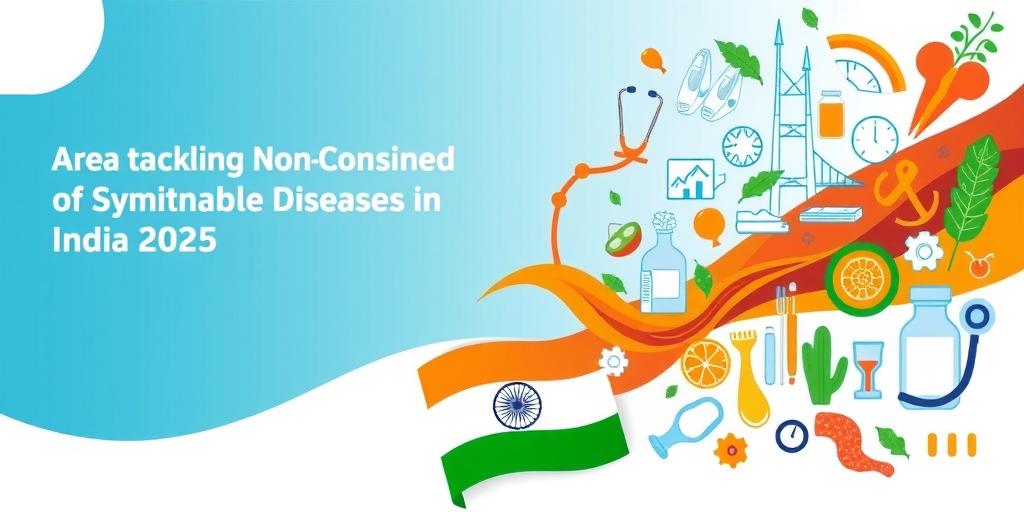Tackling Non-Communicable Diseases (NCDs) in India: 2025 Update
Non-Communicable Diseases (NCDs), such as cardiovascular diseases, cancer, diabetes, and chronic respiratory diseases, pose a significant and growing threat to public health in India. This article provides an update on the strategies and progress made in tackling NCDs in India as of 2025.
The NCD Burden in India
India faces a high burden of NCDs, which account for a substantial proportion of total deaths and disability-adjusted life years (DALYs). The rise in NCDs is driven by factors such as:
- Aging Population: As life expectancy increases, the proportion of elderly individuals, who are more susceptible to NCDs, also rises.
- Lifestyle Changes: Urbanization, sedentary lifestyles, unhealthy diets, tobacco use, and excessive alcohol consumption contribute to increased NCD risk.
- Environmental Factors: Air and water pollution exacerbate respiratory and cardiovascular diseases.
- Socioeconomic Factors: Poverty and lack of access to healthcare further compound the problem.
National Programs and Initiatives
The Indian government has launched several national programs and initiatives to address the rising burden of NCDs. These include:
-
National Programme for Prevention and Control of Cancer, Diabetes, Cardiovascular Diseases and Stroke (NPCDCS): This comprehensive program focuses on prevention, early detection, diagnosis, and management of common NCDs. It includes screening camps, health awareness campaigns, and capacity building for healthcare professionals.
-
National Tobacco Control Programme (NTCP): This program aims to reduce tobacco consumption through awareness campaigns, taxation, and enforcement of tobacco control laws.
-
National Programme for Health Care of the Elderly (NPHCE): This program focuses on providing comprehensive healthcare services to the elderly population, including prevention and management of NCDs.
-
Ayushman Bharat – Pradhan Mantri Jan Arogya Yojana (AB-PMJAY): This health insurance scheme provides financial protection to vulnerable families for secondary and tertiary care hospitalization, including NCD-related treatments.
Progress and Challenges
Significant progress has been made in several areas:
- Increased Awareness: Public awareness campaigns have helped increase awareness about NCD risk factors and preventive measures.
- Improved Screening: Screening programs have led to early detection of NCDs, enabling timely intervention.
- Enhanced Healthcare Infrastructure: Investments in healthcare infrastructure have improved access to diagnostic and treatment facilities.
However, several challenges remain:
- Inadequate Funding: Limited financial resources hinder the effective implementation of NCD control programs.
- Limited Human Resources: Shortage of trained healthcare professionals, especially in rural areas, hampers service delivery.
- Lack of Integration: Lack of integration between different healthcare programs and sectors leads to fragmented care.
- Behavioral Changes: Difficulty in promoting and sustaining behavioral changes related to diet, physical activity, and tobacco use.
Strategies for the Future
To further strengthen NCD control efforts, the following strategies are recommended:
- Increased Investment: Allocate more resources to NCD prevention and control programs.
- Strengthening Healthcare Systems: Improve healthcare infrastructure, enhance human resource capacity, and ensure access to essential medicines and technologies.
- Promoting Healthy Lifestyles: Implement comprehensive strategies to promote healthy diets, physical activity, and tobacco cessation.
- Multi-Sectoral Collaboration: Foster collaboration between government, healthcare providers, civil society organizations, and the private sector.
- Leveraging Technology: Utilize digital health technologies for disease surveillance, health education, and remote monitoring.
Conclusion
Tackling NCDs in India requires a multi-faceted approach involving prevention, early detection, treatment, and rehabilitation. While progress has been made, sustained efforts and increased investment are needed to address the rising burden of NCDs and improve the health and well-being of the Indian population. By focusing on key strategies and addressing existing challenges, India can make significant strides in reducing the impact of NCDs by 2025 and beyond.
